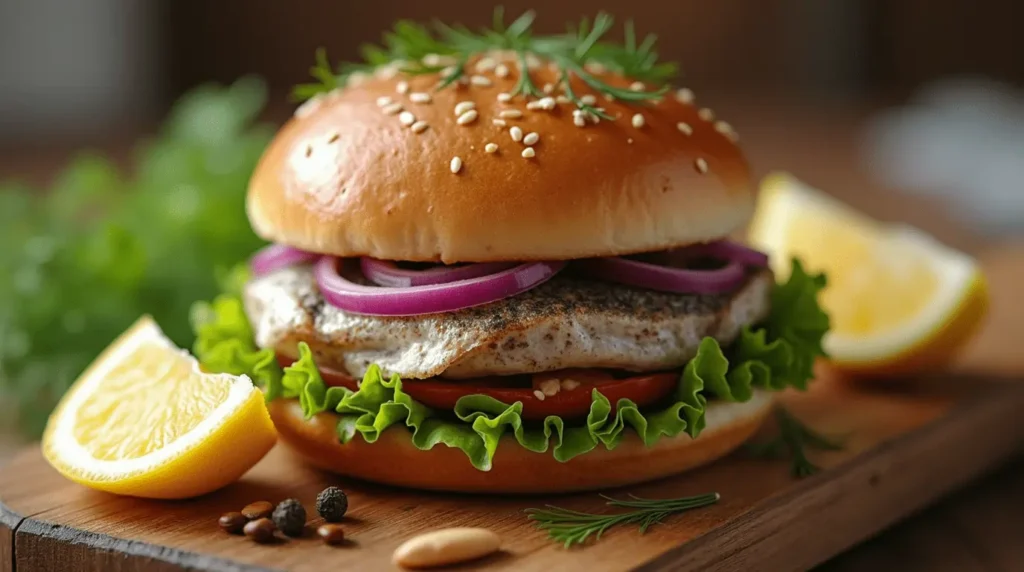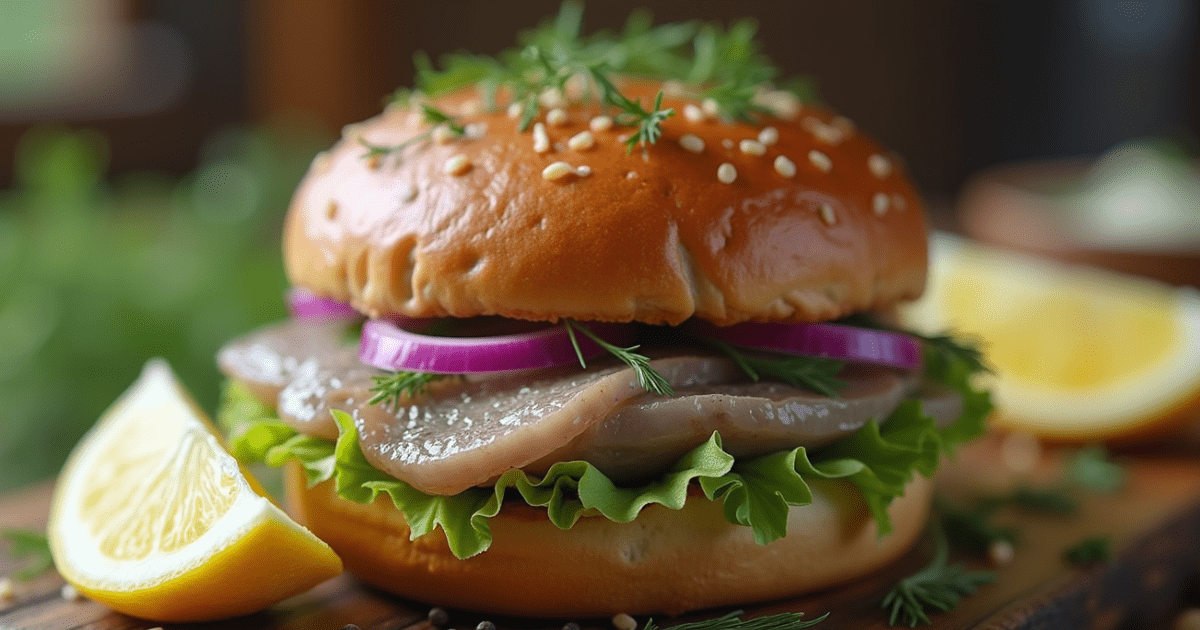Introduction
Imagine biting into a sandwich so perfectly balanced that each flavor tells a story—the salty tang of cured herring, the crunch of fresh onions, and the soft embrace of a freshly baked roll. That’s the magic of Matjesbrötchen.
Matjesbrötchen Recipe, a beloved dish in northern Europe, particularly Germany, isn’t just a sandwich; it’s an experience. Simple yet packed with flavor, this open-faced treat brings together the rich tradition of German cuisine with the pleasures of fresh, vibrant ingredients. Whether you’re seeking to recreate a festive tradition or simply explore a new culinary delight, Matjesbrötchen promises a dish that’s as delightful as it is simple. This guide will walk you through why Matjesbrötchen deserves a spot on your table, how to make it at home, and why it’s so special.
Table of Contents
What Makes This Recipe Special?
Matjesbrötchen stands out because of its unique combination of flavors. The salty, creamy Matjes herring pairs beautifully with the freshness of onions and crisp bread, while a variety of condiments add an extra layer of complexity. It’s a recipe that allows for both tradition and creativity, with options to suit every palate.
Why You’ll Love Making It
The joy of creating this dish at home lies in the simplicity and the authenticity it offers. You’re not just following a recipe; you’re reconnecting with a centuries-old culinary tradition. Plus, Matjesbrötchen is highly customizable, making it suitable for both casual meals and festive occasions. The process is simple, yet the outcome is consistently delicious.
What is Matjesbrötchen?
A Culinary Classic from Northern Europe
Matjesbrötchen is a traditional sandwich originating from northern Germany, particularly popular in coastal areas where fish is abundant. It features Matjes herring, a young, brine-cured fish that’s known for its tender texture and mild flavor. Typically, it is served in a fresh bread roll (brötchen), topped with onions and other garnishes. This iconic dish is considered a street food staple in Germany, enjoyed by locals and visitors alike.

The Origins and Cultural Importance
The origins of Matjesbrötchen trace back to the centuries-old tradition of curing fish, a practice vital to the survival of coastal communities. Over time, Matjes herring became a cherished food item, especially during the herring season in late spring. Its popularity soared during festive events, and it remains an essential part of German food culture to this day, often associated with celebrations and casual get-togethers.
Why You Should Try Making Matjesbrötchen at Home
Unmatched Freshness of Homemade Matjesbrötchen
While store-bought Matjesbrötchen can be convenient, there’s nothing like the freshness of making it yourself. By selecting the freshest ingredients and preparing them at home, you ensure the highest quality flavor. Homemade Matjesbrötchen also allows for full control over the ingredients, enabling you to adjust seasonings and toppings to your exact preferences.
A Window into German Culture
Making Matjesbrötchen is more than just cooking; it’s a window into German culinary traditions. Each step in the process connects you to a rich history of craftsmanship in food, from the curing of the herring to the art of assembling the perfect sandwich. By making it yourself, you gain a deeper appreciation for the culture and history of this beloved dish.
How Simple Ingredients Create Complex Flavors
Matjesbrötchen is a prime example of how a few simple, high-quality ingredients can come together to create a dish of remarkable depth. The key is in balancing the salty herring, the sweetness of onions, and the freshness of the bread and toppings. The beauty of Matjesbrötchen lies in its elegant simplicity, where every ingredient plays a crucial role in creating a harmonious, flavorful experience.
Ingredients for an Authentic Matjesbrötchen
The Essentials: Herring, Bread, and Toppings
To make an authentic Matjesbrötchen Recipe, you’ll need three key components: herring, bread, and toppings. The herring should be Matjes herring—tender and brine-cured. For the bread, a fresh, crusty roll (known as brötchen) is ideal. As for toppings, the traditional choices include thinly sliced onions, mustard, pickles, and a touch of dill. Each ingredient contributes to the overall taste and texture of the sandwich, so quality is paramount.
How to Choose Quality Ingredients
When selecting Matjes herring, look for tender fish that’s been well-cured. A high-quality Matjes herring should have a smooth texture, a delicate brine flavor, and a slight sweetness. As for the bread, opt for freshly baked rolls with a firm crust and soft interior. For toppings, choose the freshest vegetables and condiments—crisp onions and sharp mustard bring the sandwich to life.
Optional Ingredients to Elevate Your Recipe
While the traditional recipe is delightful on its own, several optional ingredients can add an exciting twist. Dill and horseradish offer an aromatic flair, while capers add a delightful briny punch. For a unique flavor profile, you could experiment with adding a bit of wasabi mayo or fresh herbs like parsley or chives.
How to Make Matjesbrötchen: A Step-by-Step Guide
Step 1: Preparing Your Ingredients
Start by preparing your ingredients. Clean and slice the Matjes herring, removing any bones if necessary. Thinly slice your onions and prepare any additional garnishes you plan to use, such as pickles or dill. Make sure your bread rolls are fresh and ready for assembly.
Step 2: Assembling the Perfect Matjesbrötchen
Once your ingredients are ready, it’s time to assemble the Matjesbrötchen. Start by placing the herring onto the bread roll. Add a generous amount of onions, followed by your chosen toppings, such as mustard or pickles. Make sure each layer is evenly distributed to ensure that every bite is full of flavor.
Step 3: Presentation Tips for a Stunning Dish
Presentation is key when serving Matjesbrötchen. Arrange your sandwich neatly, ensuring the toppings are visible and inviting. Garnish with a sprig of fresh dill or a slice of lemon for an extra pop of color. For an authentic touch, serve with a side of potato salad or pickles.

Creative Variations: What Else Can You Try?
Traditional German Style
Stick with the classic ingredients for a truly traditional experience. Use only Matjes herring, fresh onions, pickles, and a firm, crusty roll. The dish’s simplicity lets each ingredient stand out on its own.
Modern Twists for a Global Appeal
Add some international flair by incorporating flavors such as wasabi mayo, avocado, or Mediterranean herbs like oregano and thyme. These twists can create a fusion-style Matjesbrötchen that combines the traditional with the contemporary.
Vegan and Gluten-Free Alternatives
For those with dietary restrictions, vegan and gluten-free options are available. Plant-based fish substitutes like seaweed or tempeh can replace the herring, while gluten-free bread rolls make the dish accessible to those with gluten sensitivities.
How to Serve Matjesbrötchen: Pairings and Presentation
What to Serve Alongside Matjesbrötchen
Matjesbrötchen is often served alongside potato salad, pickles, or fresh vegetables. A crisp salad with a light vinaigrette can also complement the sandwich, adding freshness to the rich, salty flavors of the herring.
Beverage Pairings to Enhance the Experience
A cold German beer, such as a pilsner or wheat beer, pairs wonderfully with Matjesbrötchen, offering a refreshing contrast to the salty fish. Alternatively, sparkling water or a crisp white wine like Riesling can elevate the meal.
How to Store and Reheat Matjesbrötchen Recipe
Proper Storage for Ingredients and Leftovers
If you have leftover herring or assembled Matjesbrötchen, store them in airtight containers in the refrigerator. Make sure to consume the herring within a few days for optimal freshness. To prevent the bread from becoming soggy, it should be stored separately.
Reheating Techniques That Work
While it’s best to enjoy Matjesbrötchen fresh, you can reheat the bread slightly in a toaster oven or regular oven. Avoid reheating the herring, as it can lose its delicate texture and flavor.
Why Matjesbrötchen is Good for You: Nutritional Insights
Nutritional Breakdown
Matjesbrötchen Recipe is a nutrient-dense dish, offering a balance of protein, healthy fats, and vitamins. A typical serving provides a good amount of omega-3 fatty acids from the herring, which are beneficial for heart health, along with vitamins A and D.
Health Benefits of Matjes Herring
Matjes herring is an excellent source of omega-3 fatty acids, which support brain health, reduce inflammation, and promote cardiovascular health. It also contains essential vitamins and minerals like vitamin B12 and selenium, which help maintain energy levels and overall well-being.

How to Make Matjesbrötchen: A Step-by-Step Recipe
Equipment
- Knife (for slicing herring and onions)
- Cutting Board
- Small bowl (for mustard and mayonnaise mix)
- Plate (for serving)
- Spoon (for spreading the sauce, if needed)
- Serving tray (optional)
Ingredients
- 4 Matjes herring fillets (fresh or pickled)
- 4 crusty rolls (Brötchen, German bread)
- 1 small red onion, thinly sliced
- 2 tablespoons mustard (optional for tang)
- 2 tablespoons mayonnaise (optional for creaminess)
- Fresh dill (for garnish)
- 1 lemon, cut into wedges
- Fresh parsley (optional, for garnish)
Instructions
- Prepare the ingredients: Slice the red onion into thin rings and set them aside. If using, mix mustard and mayonnaise for a creamy, tangy sauce.
- Prepare the bread: Slice the crusty rolls in half. Toasting them lightly is optional but adds a lovely crunch.
- Assemble the Matjesbrötchen: Place one herring fillet on the bottom half of each roll. Add the onion rings, drizzle with the mustard-mayo sauce, and cover with the top roll.
- Garnish and serve: Add fresh dill and parsley for flavor and garnish. Serve with lemon wedges for a zesty finish.
Frequently Asked Questions (FAQs)
What makes Matjes herring unique?
Matjes herring is specially cured to preserve its tenderness and flavor, offering a milder taste compared to other types of herring.
Can I substitute other fish?
Yes, other types of brine-cured fish, like smoked salmon or pickled mackerel, can work as a substitute, but the traditional flavor comes from the Matjes herring.
What bread works best for Matjesbrötchen?
A fresh, crusty roll (brötchen) is ideal, as it holds up well against the moist herring and toppings while offering a satisfying crunch.
Are there different regional variations?
Yes, Matjesbrötchen can vary depending on the region. Some versions include different toppings or variations in the curing process of the herring.
How do I store Matjesbrötchen to keep it fresh?
Store the assembled sandwich in an airtight container and refrigerate for up to 24 hours. Be sure to store the bread separately to maintain its freshness.
Conclusion: Bring German Culinary Heritage to Your Kitchen
Matjesbrötchen is a perfect example of how simple ingredients can come together to create a dish with rich flavor and cultural significance. Whether you’re making it for a special occasion or simply to enjoy a taste of German tradition, this dish will undoubtedly become a favorite. So, roll up your sleeves, gather your ingredients, and bring this slice of German heritage into your kitchen.

